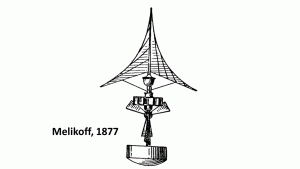It’s not easy to stand out for being weird in a crowd of 19th century flying machine inventors, but in 1877 a French engineer named Melikoff managed to do so. Chanute described his device as “a sort of screw parachute composed of two hyperbolic paraboloids united by their concavities into a sort of cone or pyramid.” Gosh, why didn’t everyone think of that? This 374 pound device was intended to actually carry a person, although where this person would sit is not clearly shown in the drawing.
Chanute says very little about this proto-helicopter except to note that it did not work and it was odd. In less than half a page of text, Chanute actually uses the word “oddity” twice, explaining “the apparatus as a whole is scarcely worth experimenting with, and has been chiefly described because of its oddity.” And that’s why I love it – because it’s awesomely weird.
At a time when no flying machine had ever worked, it just didn’t make much sense to copy what everyone else was doing. And Melikoff was clearly not copying anyone else. A true original, he set a standard for aviation weirdness that nobody has even touched for more than 100 years.
LESSON: Be weird! Try an odd approach, particularly if everyone else’s conventional approaches are all failing.
